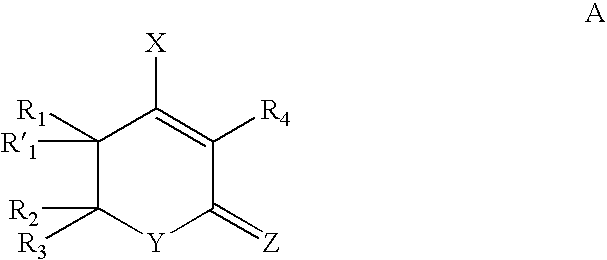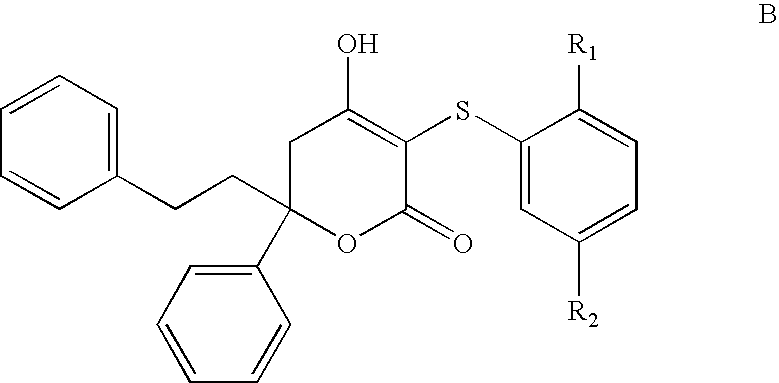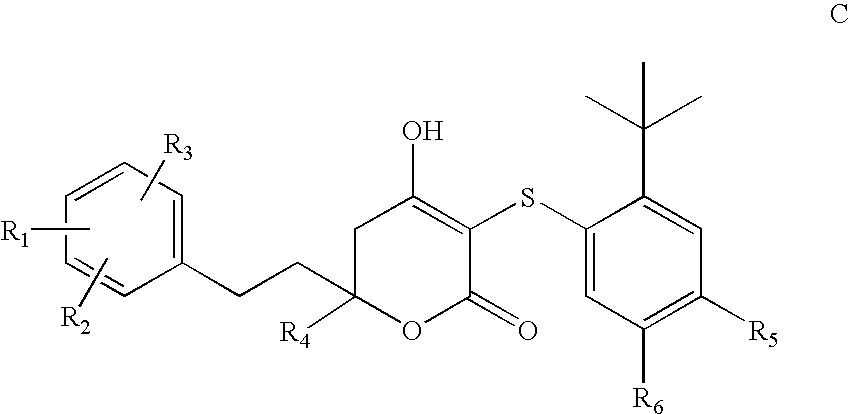HIV protease inhibitors
a protease inhibitor and peptidomimetic technology, applied in the field can solve the problems of limited bioavailability, high biliary excretion, and relatively poor solubility of hiv protease inhibitors by their peptidomimetic nature, and achieves less toxicity risk, reduced metabolism and/or clearance, and high plasma levels
- Summary
- Abstract
- Description
- Claims
- Application Information
AI Technical Summary
Benefits of technology
Problems solved by technology
Method used
Image
Examples
example a-1
5-Methyl-thiazole-4-carbaldehyde
A solution of 2.48 g (14.4 mmol) of 5-methyl-thiazole-4-carboxylic acid ethyl ester (J. Chem. Soc., Perkin Trans. 1, 1982:159-164) in dichloromethane (CH2Cl2) (50 mL) was cooled to −78° C. under nitrogen. DIBAL (Diisobutylaluminum hydride) (1.0 M in CH2Cl2, 15 mmol) was added dropwise, and the solution was stirred at low temperature for 45 minutes. Another 10 mmol of DIBAL was then added dropwise, and the mixture was stirred for another 45 minutes. A solution of methanol (MeOH):acetic acid (10 mL:5 mL) was added slowly, followed by H2O. The organic layer was separated, washed with brine, and dried (MgSO4). Concentration gave a residue which was chromatographed on silica gel, eluting with 2:1 hexane:ethyl acetate (EtOAc), to give the title compound.
1H NMR (CDCl3): δ 2.76 (s, 3H), 8.58 (s, 1H), 10.14 (s, 1H).
example a-2
2-Methyl-thiazole-4-carbaldehyde
A mixture of 5.52 g (30 mmol) of 4-chloromethyl-2-methylthiazole hydrochloride and 0.5 M NaOH (180 mL) was refluxed for 8 hours and then stirred for 18 hours at room temperature. EtOAc and H2O were added. The organic phase was separated, washed with brine, and dried (MgSO4). Concentration gave 4-(hydroxymethyl)-2-methylthiazole.
1H NMR (CDCl3): δ 2.63 (s, 3H), 4.66 (s, 2H), 6.96 (s, 1H).
The crude product (2.2 g, 17 mmol) was oxidized with MnO2 (20 g) in 75 mL of CHCl3 for 16 hours. The suspension was filtered, and the filtrate was concentrated. The residue was chromatographed on silica gel, eluting with 2:1 hexane:EtOAc, to give the title compound.
1H NMR (CDCl3): δ 2.71 (s, 3H), 7.98 (s, 1H), 9.89 (s, 1H).
example a-3
2-iso-Propyl-thiazole-4-carbaldehyde
A solution of 2.7 g (13 mmol) of 2-isopropyl-thiazole-4-carboxylic acid ethyl ester (J. Med. Chem., 1998:602-617) in CH2Cl2 (50 mL) was cooled to −78° C. under nitrogen and treated dropwise with DIBAL (15 mL of 1.0 M in CH2Cl2; 15 mmol). The mixture was stirred at low temperature for 45 minutes and then treated with another 15 mL of DIBAL. The solution was stirred for 1 hour at −78° C. Five percent citric acid was added, and the mixture was extracted with EtOAc (3×100 mL). The combined extracts were washed with brine, dried (MgSO4), and concentrated. Chromatography of the residue over silica gel, eluting with 3:1 hexane:EtOAc, gave the title compound.
1H NMR (CDCl3): δ 1.37 (d, 6H), 3.30-3.35 (m, 1H), 8.01 (s, 1H), 9.93 (s, 1H).
PUM
| Property | Measurement | Unit |
|---|---|---|
| solubility | aaaaa | aaaaa |
| frequency | aaaaa | aaaaa |
Abstract
Description
Claims
Application Information
 Login to View More
Login to View More - R&D
- Intellectual Property
- Life Sciences
- Materials
- Tech Scout
- Unparalleled Data Quality
- Higher Quality Content
- 60% Fewer Hallucinations
Browse by: Latest US Patents, China's latest patents, Technical Efficacy Thesaurus, Application Domain, Technology Topic, Popular Technical Reports.
© 2025 PatSnap. All rights reserved.Legal|Privacy policy|Modern Slavery Act Transparency Statement|Sitemap|About US| Contact US: help@patsnap.com



